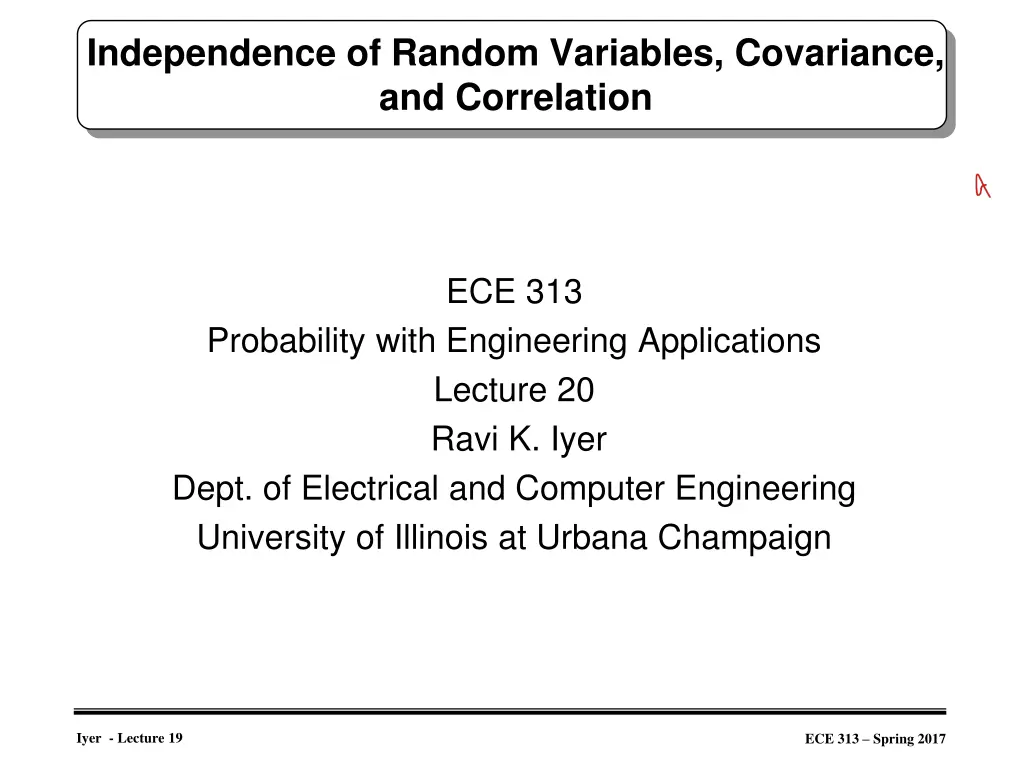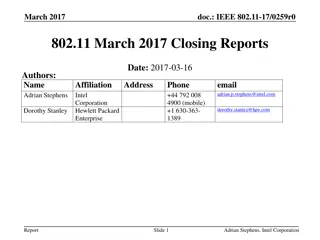
Understanding Joint Distribution Functions in Probability
Explore the concept of joint distribution functions in probability theory, focusing on the relationships between multiple random variables and their cumulative probability distributions. This lecture covers topics such as covariance, correlation, and bivariate normal distributions, providing insights into analyzing the interdependence of random variables in engineering applications.
Uploaded on | 1 Views
Download Presentation

Please find below an Image/Link to download the presentation.
The content on the website is provided AS IS for your information and personal use only. It may not be sold, licensed, or shared on other websites without obtaining consent from the author. If you encounter any issues during the download, it is possible that the publisher has removed the file from their server.
You are allowed to download the files provided on this website for personal or commercial use, subject to the condition that they are used lawfully. All files are the property of their respective owners.
The content on the website is provided AS IS for your information and personal use only. It may not be sold, licensed, or shared on other websites without obtaining consent from the author.
E N D
Presentation Transcript
Independence of Random Variables, Covariance, and Correlation ECE 313 Probability with Engineering Applications Lecture 20 Ravi K. Iyer Dept. of Electrical and Computer Engineering University of Illinois at Urbana Champaign Iyer - Lecture 19 ECE 313 Spring 2017
Todays Topics and Announcements Joint Distribution Functions review of concepts Conditional Distributions Independence of Random Variables Covariance and Correlation Announcements: Group activity in the class, next Week,. Final project will be released Monday Concepts: Hypothesis Covariance and correlation Project schedules on Compass and Piazza testing, Joint distributions, Independence, Iyer - Lecture 19 ECE 313 Spring 2017
Joint Distribution Functions We have concerned ourselves with the probability distribution of a single random variable Often interested in probability statements concerning two or more random variables Define, for any two random variables X and Y, the joint cumulative probability distribution function of X and Y by = b Y a X P b a F }, , { ) , ( , a b The distribution of X (Marginal Distribution)can be obtained from the joint distribution of X and Y as follows: } { ) ( FX = a F = a P X a { , } P X a Y = ( , ) Iyer - Lecture 19 ECE 313 Spring 2017
Joint Distribution Functions Contd = = ( ) { } ( , ) FY b P Y b F b Similarly, Where X and Y are both discrete random variables - define the joint probability mass function (joint pmf) of X and Y by { ) , ( X P y x p = = = , } x Y y Probability mass function of X ( x = ( ) ( , ) p x p x y X : , ) 0 y p y ( x = ( ) ( , ) p y p x y Y : , ) 0 x p y Iyer - Lecture 19 ECE 313 Spring 2017
Joint Distribution Functions Contd If X and Y are jointly continuous defined for all real x and y, then = B Y A X P } , { B A ( , ) f x y dxdy f(x,y) Called the joint probability density function of X and Y . Marginal probability density of X: = { } { , ( , )} P X A P X A Y = ( , ) f x y dxdy A ( = ) f x dx X A = ( ) ( , ) fX x f x y dy is the probability density function of X. The probability density function of Y is because: = ( ) ( , ) fY y f x y dx a b = = ( , ) ( , ) ( , ) F a b P X a Y b f x y dydx Iyer - Lecture 19 ECE 313 Spring 2017
Example: Bivariate normal distribution Visualizing multivariate normal distribution of an n-dimensional vector x Example: bivariate normal distribution n = 2 ? = 1, 1 1 0.5 .5 1 = Iyer - Lecture 19 ECE 313 Spring 2017
Example: Bivariate normal distribution n = 2 ? = 1, 1 1 0.5 1 = .5 2-D scatter plot of 200 samples from the bivariate normal distribution 3-D plot of 200 samples from the bivariate normal distribution Iyer - Lecture 19 ECE 313 Spring 2017
Example - Joint Distribution Functions The jointly continuous random variable X and Y have joint pdf v v = u u Iyer - Lecture 19 ECE 313 Spring 2017
Example - Joint Distribution Functions The jointly continuous random variable X and Y have joint pdf Find P[Y > 3X] v = 3u v v = u u Iyer - Lecture 19 ECE 313 Spring 2017
Joint Distribution Functions Contd Proposition: if X and Y are random variables and g is a function of two variables, then = [ ( , )] ( , ) ( , ) E g X Y g x y p x y y x = ( , ) ( , ) g x y f x y dx dy For example, if g(X,Y)=X+Y, then, in the continuous case + = + [ ] ( ) ( , ) E X Y x y f x y dx dy = + ( , ) ( , ) xf x y dx dy yf x y dx dy = + [ ] [ ] E X E Y Iyer - Lecture 19 ECE 313 Spring 2017
Joint Distribution Functions Contd Where the first integral is evaluated by using the foregoing Proposition with g(x,y)=x and the second with g(x,y)=y In the discrete case Joint probability distributions may also be defined for n random variables. If are n random variables, then for any n constants a a ,..., , 2 1 ] ... [ 1 2 2 1 1 n n E a X a X a X a E = + + + = + [ ] [ ] [ ] E aX bY aE X bE Y , ,..., n a X X X 1 2 n + + + [ ] [ ] ... [ ] X a E X a E X 1 2 2 n n Iyer - Lecture 19 ECE 313 Spring 2017
Example 2 Let X and Y have joint pdf Determine the marginal pdfs of X and Y. Are X and Y independent? Iyer - Lecture 19 ECE 313 Spring 2017
Example 2 (Contd) Similarly, So clearly, Iyer - Lecture 19 ECE 313 Spring 2017
Example 3 Iyer - Lecture 19 ECE 313 Spring 2017
Example 3 (Contd) a) Marginal PDF of Y: b) Marginal PDF of X: Iyer - Lecture 19 ECE 313 Spring 2017
Example 3 (Contd) c) We first calculate the joint density function of X and Y-X Then summing up with respect to i, we get the marginal distribution of Y X, which is for k: Iyer - Lecture 19 ECE 313 Spring 2017
Conditional Probability Mass Function Recall that for any two events E and F, the conditional probability of E given F is defined, as long as P(F) > 0, by: Hence, if X and Y are discrete random variables, then the conditional probability mass function of X given that Y = y, is defined by: for all values of y such that P{Y = y}>0. Iyer - Lecture 19 ECE 313 Spring 2017
Conditional CDF and Expectation The conditional probability distribution function of X given Y =y is defined, for all y such that P{Y = y} > 0, by: Finally, the conditional expectation of X given that Y = y is defined by: All the definitions are exactly as before with the exception that everything is now conditional on the event that Y = y. If X and Y are independent, then the conditional mass function, distribution, and expectation are the same as unconditional ones: Iyer - Lecture 19 ECE 313 Spring 2017
Conditional Probability Density Function If X and Y have a joint probability density function f (x, y), then the conditional probability density function of X, given that Y = y, is defined for all values of y such that fY(y) > 0, by: To motivate this definition, multiply the left side by dx and the right side by (dx dy)/dy to get: Iyer - Lecture 19 ECE 313 Spring 2017
Binary Hypothesis Testing In many practical problems we need to make decisions about on the basis of limited information contained in a sample. For instance a system administrator may have to decide whether to upgrade the capacity of installation. The choice is binary in nature (e.g. an upgrade or not) To arrive at a decision we often make assumptions or a guess (an assertion) about the nature of the underlying population or situation. Such an assertion which may or may not be valid is called a statistical hypothesis. Procedures that enable us to decide whether to reject or accept hypotheses, based on the available information are called statistical tests. Iyer - Lecture 19 ECE 313 Spring 2017
Binary Hypothesis Testing: Basic Framework Learning a decision rule based on past measurements Measurements Previous MRI Scan Machine Images captured from brain when H1 or H0: e.g. X = No. of abnormal spots in the image H1: Patient has a tumor H0:Patient doesn t have a tumor Binary: Either hypothesis H1 is true or hypothesis H0 is true. Based on which hypothesis is true, system generates a set of observations X. We use the past observations and find the conditional probabilities of different patterns under each hypothesis: e.g. What is the probability of observing two abnormal spots (X = 2) given patient has a tumor (H1)? Iyer - Lecture 19 ECE 313 Spring 2017
Binary Hypothesis Testing: Basic Framework formulate a decision rule based on past measurements Measurements Training Previous Testing New Measurements Either hypothesis H1 is true or hypothesis H0 is true. Based on which hypothesis is true, system generates a set of observations X. We measure the past observations to learn the conditional probabilities of different patterns under each hypothesis: e.g. What is the probability of observing two abnormal spots (X = 2) if patient has a tumor (H1)? Next we formulate a decision rule that is then used to determine whether H1 or H0is true for new measurements. Note that the system has uncertainty or the features are not the best, so the decision rule can sometimes declare a true hypothesis, or it can make an error Iyer - Lecture 19 ECE 313 Spring 2017
Example 1 Suppose the data is from a computer aided tomography (CAT) scan system, and the hypotheses are: H1: A tumor is present H0: No tumor is present We model the number of abnormal spots observed in the image by a discrete random variable X. Suppose: If hypothesis H1 is true (given), then X has pmf p1 If hypothesis H0 is true (given), then X has pmf p0 Note that p1 and p0 are conditional pmf s, described by a likelihood Matrix Given a tumor, what is the probability of observing 3 spots P (X = k | H1) => P (X = k | H0) => Iyer - Lecture 19 ECE 313 Spring 2017
Example 1: Decision Rule A decision rule specifies for each possible observation (each of the possible values of X), which hypothesis is declared. Typically a decision rule is described using a likelihood matrix. Here we underline one entry in each column, to specify which hypothesis is to be declared for each possible value of X. Exampl:e: A probability-based decision rule: H1 is declared when the probability of an observation given hypothesis H1 is higher than its probability given H0: If we observe X = 2,3 in the new measurements, H1 (tumor) is declared, otherwise H0 (no tumor). Declare H1 Declare H0 Example intuitive decision rule: H1 is declared whenever X 1 : Iyer - Lecture 19 ECE 313 Spring 2017
Binary Hypothesis Testing In a binary hypothesis testing problem, there are two possibilities for which the hypothesis is true, and two possibilities for which hypothesis is declared: H0 = Negative or null hypothesis, H1 = Positive or alternative hypothesis So there are four possible outcomes: 1. H1 is declared given Hypothesis H1 is true. => True Positive 2. H1 is declared given Hypothesis H0 is true. => False Positive Alarm) (False 3. H0 is declared given Hypothesis H0 is true. => True Negative Iyer - Lecture 19 ECE 313 Spring 2017
Probability of False Alarm and Miss Two conditional probabilities are defined: ( declare P pmiss= = ( | ) p P declare H true H => Type I Error 1 0 false alarm | ) H true H => Type II Error 0 1 p is the sum of entries in the H0 row of the likelihood matrix that are not underlined: false alarm = + + = 3 . 0 2 . 0 1 . 0 6 . 0 p false alarm p is the sum of entries in the H1 row of the likelihood matrix that are not underlined: miss = 0 . 0 p miss Iyer - Lecture 19 ECE 313 Spring 2017
Decision Rule If we modify the sample decision rule in the previous example to declare H1 when X = 1: p Then the will decrease to: The will increase to: miss p 3 . 0 false alarm 3 . 0 + 6 . 0 + 9 . 0 = 0 . 0 So what decision rule should be used? Trade-off between the two types of error probabilities Evaluate the pair of conditional error probabilities for multiple decision rules and then make a final selection ( , ) p p false alarm miss Iyer - Lecture 19 ECE 313 Spring 2017






















